
February 16, 2004
Isaac Leung (P.Eng.) got a degree in Engineering Physics followed by a Master's in Electrical Engineering after which he promptly got a job as a product engineer at a company which makes high speed datacom chips. Following the dot-com meltdown, he's back at school studying biophysics and optical properties of semiconductors. He is old enough to have cut his computer teeth on Commodore 64's and first played with OS/2 1.3 EE while at a summer job with IBM. The first PC he ever owned came with Windows 95, but he soon slapped on OS/2 Warp 3 and has been Warping ever since. In between looking for a new job, he plots to take over the world.
If you have a comment about the content of this article, please feel free to vent in the OS/2 e-Zine discussion forums.
There is also a Printer Friendly version of this page.
|
Previous Article |
|
Next Article |

Need a dictionary?
Just in time to go with the NLS Office Suite review, we have a couple of nifty little language tools, both written in Java, and both free. We take a quick look at each one and what it can do. Don't forget that you need to make sure you have the appropriate fonts installed. A Unicode set comes with Java 1.3, but there are also many other sets that are freely available on-line.
If anyone knows of other similar tools, drop us a line and let us know!
JavaDict
Slightly unfortunately named, but I gather this is due to it being an entry in a Java programming contest or somesuch. JavaDict is actually a Java-based Japanese dictionary. Yup, just Japanese, no other language. By the way, I don't speak or read Japanese, so please feel free to correct any errors!You can download it free of charge as it is under the GNU license. (So yes, if some of you feel like modifying for a Chinese dictionary, feel free I guess).
There isn't really much of an installation, just unzip it into some directory and type:
java JavaDictto start up the dictionary. It works fine using Java 1.1.8 using a PII-300MHz machine.
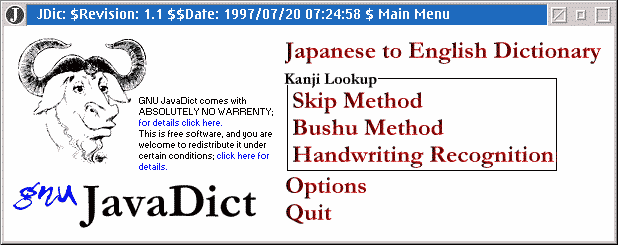
Options
The only thing you can change in the options is to display the pronunciation in Roman letters or Japanese Kana. Those of you trying to learn will probably want to use the Roman letters (i.e. a,b,c,d, etc.), but if you're really familiar with the Japanese system, you can read the Kana pronunciation. A shame it can't do both at the same time though.Input Method
The other three menu items are simply the input methods used to look up a word.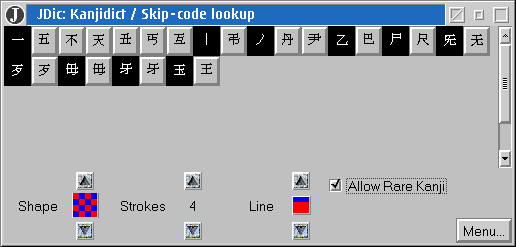
I'm not familiar with the Skip method. But you need to essentially choose the "layout" of the character and the select the 2 main components of the word before finally selecting the correct one.
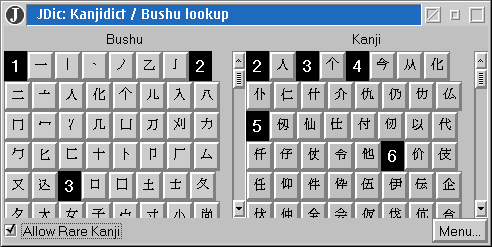
I'm much more familiar with the Bushu method, in which you select the major character by number of strokes, then find the "minor" character by stroke number to finally find the complete word. (Really, it's not as obtuse as you think. It's the same thing as first looking for "E", and then "n" and then "g" and so on until you complete the word).
By far the most intriguing method to me is the handwriting recognition method.
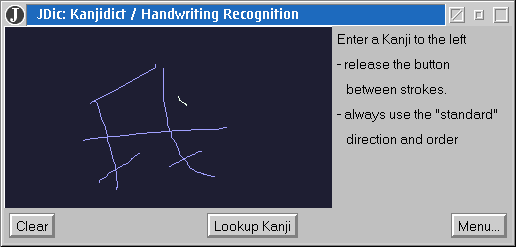
Using this input method, you simply write the word as you would on paper (which
means you have to write in the proper stroke order) and it tries to recognize the
word. It is much easier to accomplish if you have a pen input. The worst is probably
using a Trackpoint.
It's not bad, it actually manage to recognize the scrawl I drew (using a touchpad).
[In case you're wondering how I got it to work, Japanese "Kanji" ( ), literally is the same word as Chinese "Hanzi" (
), literally is the same word as Chinese "Hanzi" ( ).
This literally translates as Han letters, Han being the majority ethnic population in China. So,
the Japanese Kanji words and Chinese characters are often similar or even identical, though there have been
obvious divergences over time. They will have different pronunciation, but similar meaning].
).
This literally translates as Han letters, Han being the majority ethnic population in China. So,
the Japanese Kanji words and Chinese characters are often similar or even identical, though there have been
obvious divergences over time. They will have different pronunciation, but similar meaning].
Either way you choose, once you select the appropriate word, you get some more information about it.
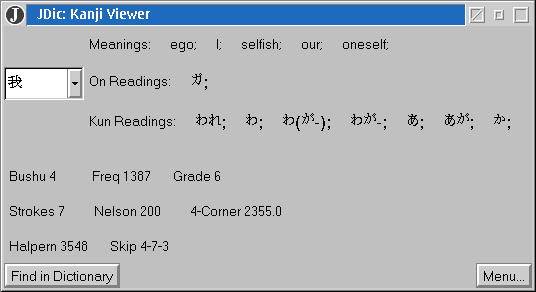
It contains, of course, the definition, as well as the pronunciation and other information.
If you have installed EDICT,
you can do even better, and see entire words (or phrases) pertaining to that word. Just click on the "Find in Dictionary" button.
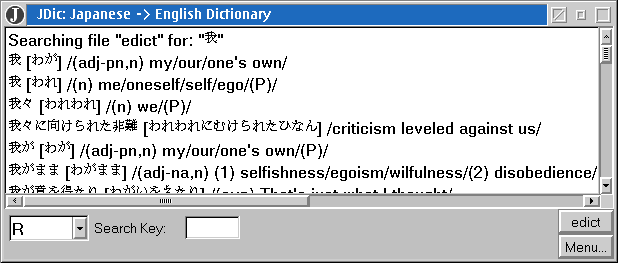
All in all, a very handy, and free little tool.
T
This tool is part of the set of On-line Chinese Tools, which are generally freely available for use. The Java Chinese Character dictionary is currently in beta, and there is no specific download link, but you can download the .JAR file directly that the HTML page refers to.A sample script to start it up might be:
SET JAVA_HOME=C:\Java131\jre SET HOME=E:\Programs\Zidian C:\Java131\jre\bin\java -Duser.home=E:\Programs\Zidian -jar zidian.jarBe warned, it needs the javacomm.zip file that comes the Java 1.3.1 package. If you want to stick with Java 1.1.8, you can start it with something like:
java -classpath %CLASSPATH%;E:\Programs\Zidian\zidian.jar zidian
This is a straightforward Chinese character dictionary (i.e. not phrases or whole words)
that is organized by radical (equivalent to the Japanese Bushu method).
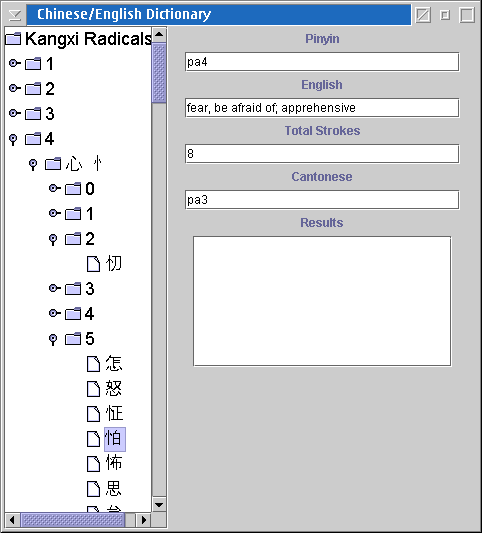
You need to locate the main radical by number of strokes, then the minor character again by number of strokes. Once found, the English definition is given on the right pane of the window, along with the Pinyin (Mandarin) pronunciation. Surprisingly (in a good way!) it also gives the Cantonese pronunciation (using the Yale romanization). Surprising because it is relatively rare for a non-native speaker to try and learn Cantonese due to the large number of tones involved.
[The number you see with the pronunciation denotes the tone. Unlike nearly most other languages, the tone is exceedingly important. (It could mean the difference between "mom" and "horse"). In Mandarin there are 4 and Cantonese, between 6 and 9 depending on how you count it. While it means that a lot of information can be conveyed, it is also incredibly difficult to learn properly, especially if you're tone deaf. English can be easily understood even with heavy accents. It is very hard to understand Chinese if you do not speak exactly right.]
There also exists CEDICT, the equivalent to EDICT for Japanese. Unfortunately, the only front-end to this database/dictionary is on-line. Perhaps someone could coerce JavaDict to use the Chinese dictionary instead. That would be nice.
Related Links
JavaDict Java Japanese-English DictionaryEDICT
Java Chinese-English Character dictionary
CEDICT
Omniglot guide to the Japanese Writing System
Omniglot guide to Chinese
|
Previous Article |
|
Next Article |